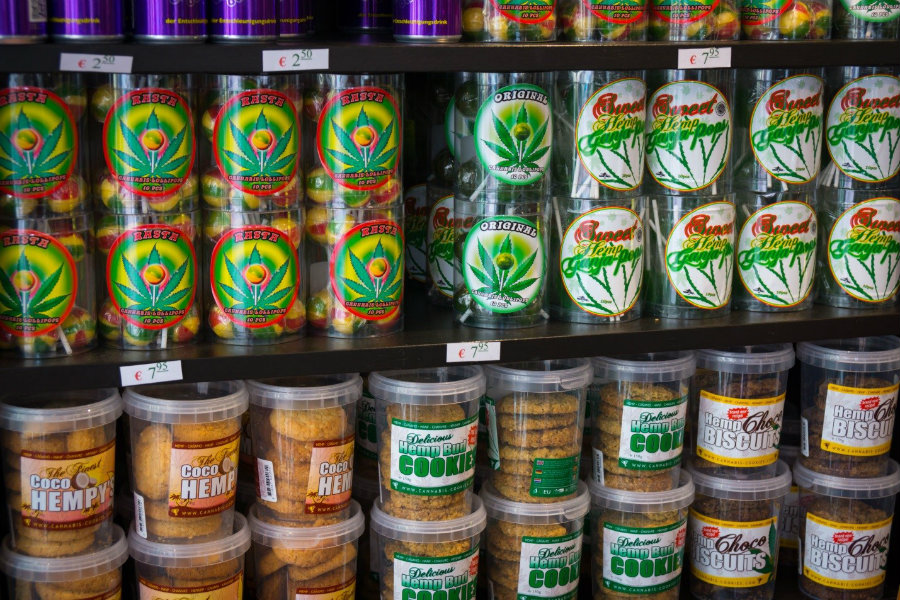A new requirement has Colorado pot edible manufacturers to stamp their products with a diamond-shaped mark containing the letters THC, not only on the packaging but also on the product itself.
The guideline will be put into action on Saturday, as authorities have deemed necessary distinguishing pot edibles from regular snacks and products, which will make pot cookies and brownies not go unnoticed in schools, workplaces, or any other location where eating is permitted.

Pot edibles already require being in childproof containers, labeled with warnings for children, pregnant and nursing women, and for avoiding consumption while performing dangerous tasks such as driving or operating heavy machinery.
‘That cookie has pot in it’
Colorado Representative Jonathan Singer, who promoted the law, commented that it is important that people can easily tell the difference between a brownie that one buys at a convenience store or a homemade brownie, and a marijuana brownie that will cause adverse psychotic effects. Although there is little statistical data concerning the rates of people eating pot edibles by accident, the number of children treated for accidental marijuana consumption in Denver increased after legalization. But all of this goes in place with marijuana having no severe side effects, even when consumed in large quantities.
According to physicians, accidental marijuana consumption occurs mostly in cases where children are left unsupervised, and the product is poorly stored. Since 2009, only 81 children have been treated for accidental marijuana ingestion in Denver. Dr. Michael DiStefano, an emergency pediatrician at the Children’s Hospital in Colorado, attended several children that mistakenly ingested marijuana edibles.
“They pick up a Swedish Fish and it looks like a gummy candy, and they eat it without knowing that there’s marijuana in the product,” he stated.
Dr. DiStefano acknowledges that kids who have ingested marijuana can have respiratory events that can become fatal, although no such event has occurred. Products containing THC for recreational use must not contain more than 10 mg of the psychoactive compound.
But the stamp does not solve all of the problems that come with edible marijuana products, as there are marijuana-infused sodas, powders, lollipops, lip-balm, crèmes, and pretty much any product that can be infused with some cannabis oil extract. The new guideline forced manufacturers to buy new packaging labels and molds to allow their products to be adequately marked that they contain THC.
“We spent a long time saying that this isn’t a real concern, but after a couple years of hearing these concerns I recognized that this was a true problem,” stated Dan Anglin, CEO of Colorado pot candy manufacturer Americanna.
Even if accidental consumption is not completely eradicated, the guideline will help ensure that both children and adults know whether a cookie or brownie contains marijuana, and refrain from consuming it or at least be aware of the circumstance.
Pot edibles, a whole new type of product
Because marijuana production is an entirely new industry, investors and entrepreneurs are jumping at the possibility of participating in this niche of the economy. Just by itself, marijuana is a product that can be sold at dispensaries. It implies a production and packaging process, including a necessity of owning a storefront. But there’s also the edible part, where marijuana oil can be mixed with almost any consumable product, including chocolates, butter, and candy. The so-called “test case” states are Colorado and Washington, but it appears that the tests have been more than successful and are being transformed into tycoon endeavors.
According to state administration, Washington has produced over $186 million in marijuana tax revenue as of June, and it is expected to increase another 50 percent by the end of 2017’s fiscal year. Colorado did not fall behind, as it raised over $135 million in that same period, with similar predictions of surpassing expectations. Nationwide, Americans spent $73.5 million on edible pot.
One of the primary concerns of marijuana is its effect on drivers, and rightfully so, as the number of fatal crashes involving drivers that have consumed marijuana has increased. But coincidentally, the overall amount of fatal crashes in Colorado and Washing has also increased, which does not include pot-consuming drivers in a concerning trend. Furthermore, because THC resides in a consumer’s bloodstream for several days, it is hard to determine if the driver was indeed high at the time of the accident. With the current evidence, the U.S. Department of Transportation concluded in 2015 that marijuana use has little to no implications in the likelihood of being involved in a fatal crash.
Seeing the results, Colorado residents still appear to be supporting of recreational marijuana, as most voters believe that the impact of legalization has been mostly positive. And because tax revenue has been so high, Colorado lawmakers decided to allocate funds for schools in the form of bullying prevention.
At least 50 schools will receive $2.9 million produced from tax surplus to elaborate on bully prevention coaching, which will advise parents, students, and teachers to help eradicate bullying from their respective school districts. Reportedly, the programs focus on the causes of bullying and not on the punishment, as it is necessary first to understand the source of the problem to eliminate it then actually. Basically, legal pot will help kids in Colorado to live a better life.
Source: CBC
